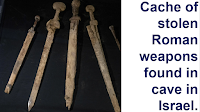A Triton statue has been unearthed by archaeologists excavating a Roman mausoleum at Teynham in Kent, southern England. A section of Roman wall was he discovered at the site in 2017 during exploratory excavation work by a commercial archaeological company, related to a planned roundabout on the A2 Road (which follows the path of the Roman Wattling Street), with formal excavations by the Canterbury Archaeological Trust beginning in May 2023. These excavations found that the wall section was part of a walled enclosure with an area of about 30 m³, surrounding a square structure with an area of about 8 m³, with the whole standing in a precinct enclosure 65 m by 70 m, and surrounded by a ditch.
Previous finds from the site include a Roman coin thought to date from between 320 and 330 AD, giving an approximate age to the site. The Triton figure was found placed carefully within a clay water tank which had been filled with burnt material, and lends support to the idea that the mausoleum is related to the nearby Bax Farm archaeological site, Roman villa decorated with maritime deities.
The exact nature of Triton changed over time. To the Hellenistic Greeks, he was a son of Poseidon and Amphitrite (the God and Goddess of the Sea, respectively) and an important Sea God in his own right. To the Early Romans, he was a son of Neptune, a minor Sea God usually depicted as a Merman. However, over time this idea appears to have changed, with the singular God Triton turning into a more generic term for a race of Mermen, the Tritons, who served as messengers of the God Neptune. Given the presumed Late Roman date of the Teynham Mausoleum this may have been the intended nature of the Triton statue found there.
See also...
Follow Sciency Thoughts on Facebook.
Follow Sciency Thoughts on Twitter.








